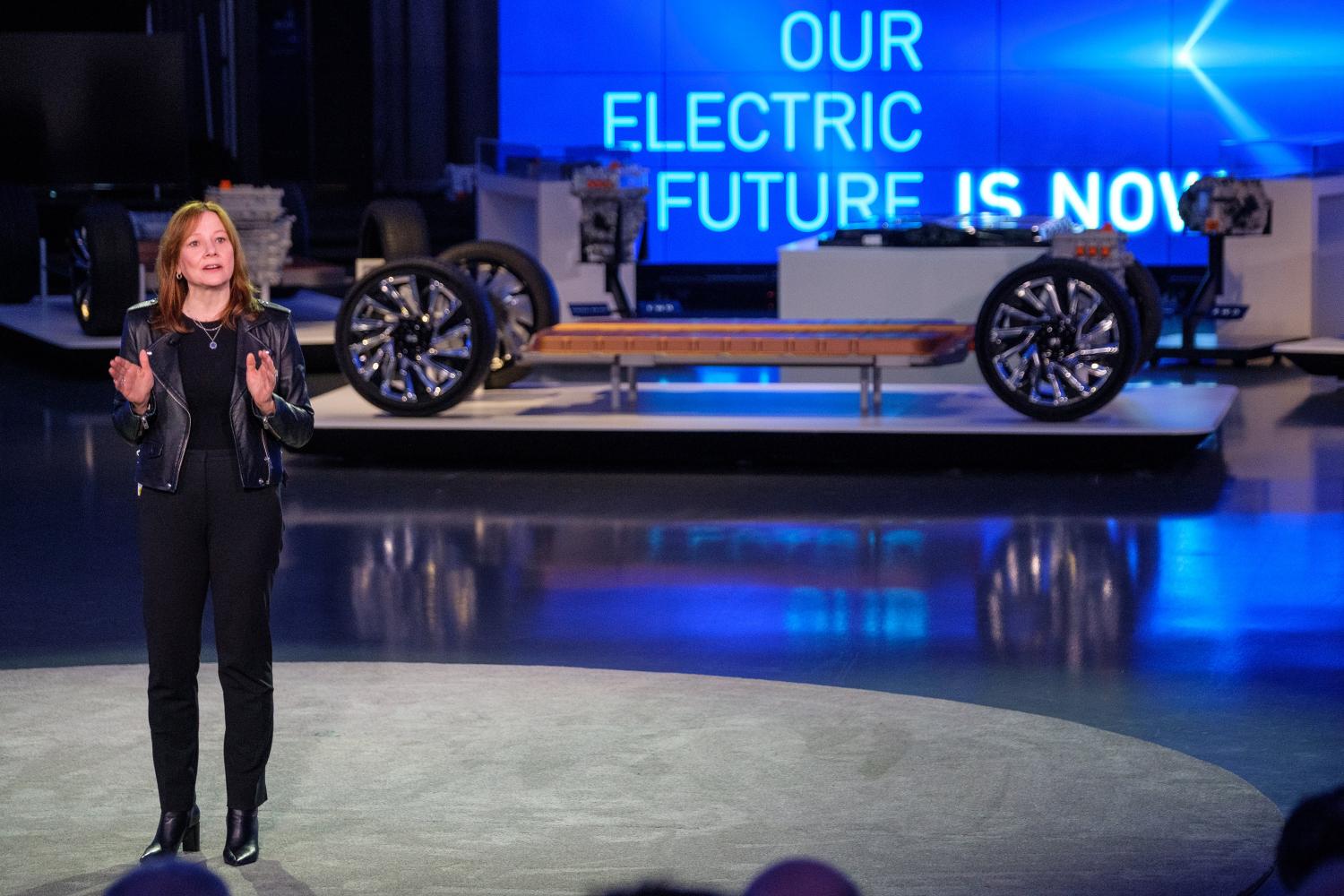
Earlier this week, we reported on General Motors’ vehicle electrification strategy, which promises to usher in a range of electric vehicles (EVs) across GM's portfolio of brands over the next five years, with offerings in multiple market segments.
Committing $20 billion to the effort, GM’s CEO and chairman, Mary Barra (shown above), believes the investment in EVs presents a huge opportunity for the company.
In order to grow EV sales quickly, efficiently and profitably, GM’s strategy is to take a flexible and modular approach to vehicle design, allowing one model to inform the next and so on. At the heart of the product portfolio is the automaker's next-generation Ultium battery technology.
The first vehicle GM has shown publicly that will use its third-generation EV platform with Ultium battery technology is the Cruise Origin, which is actually an autonomous, shared electric vehicle (think: a driverless shared taxi, rather than personal passenger vehicle). At this stage, GM has not announced when the car will hit the roads, but as with all driverless AVs, going into service is no doubt subject to regulatory challenges as much as technical ones.
GM’s upcoming EV portfolio on display to the media at the company’s Design Dome in Michigan last week, though, was really focused on cars, trucks and SUVs, where drivers will still sit behind a steering wheel. What drivers can expect from GM is, in short, much more choice.
First to market: Revitalized Chevrolet Bolts
GM’s first two new EVs, however, won’t feature the new Ultium battery technology since they are scheduled for release in shorter order and will precede the ramp-up of the newer generation of vehicles.
A refreshed Chevrolet Bolt will launch later this year, which will look similar to the existing offering, while the Bolt EUV (electric utility vehicle) will be a slightly larger crossover-type variant based on the Bolt platform.
The EUV is slated to be launched in the summer of 2021 and will be the first vehicle outside of the Cadillac brand to feature Super Cruise, GM’s hands-free driving technology for the highway.
New electric Cadillacs will spearhead GM’s luxury offering
The most pre-production-ready vehicle on display featuring the third-generation Ultium battery platform is the new Cadillac Lyriq, which GM says will be revealed to the public in April.
This luxury SUV is recognizable from the front end as a Cadillac but with a more futuristic take and is shown in silhouette in the image below. The interior features an attractive wrap-around digital dashboard, eschewing the tablet-style display that Tesla pioneered and Ford has picked up for its Mustang-branded Mach E electric vehicle. GM promises details of the Lyriq’s launch will be shared during the April reveal.

A silhouette of the Cadillac Lyriq SUV (courtesy GM).
The wraps also came off the Cadillac Celestiq, a brand new vehicle which is still very much in the early concept stage.The exterior shows its form as both a long and sleek sedan with a sloping tail end, and GM says this car will be Cadillac's flagship model when released. Celestiq will be handbuilt locally in Michigan. As of press time, GM has not yet indicated when it will be released.
Rounding out the new Cadillacs, customers can expect an electric version of the brand's full-size SUV, the Escalade, which is recognizable as an Escalade — very large and as imposing as the gasoline variant has always been, and no more aerodynamic.
Other very large vehicles are also in GM’s pipeline.
GM flips the script on the Hummer
Yes, the Hummer is back. The exuberant, gas-guzzling, military-vehicle-inspired behemoth that characterized the reign of the large SUV in the pre-financial-crisis era of the mid 2000s will chart a new path in EV form for the 2020s.
Immediately recognizable as a Hummer, GM plans to produce two all-electric variants, and neither compromises on their sizable footprint. Firstly, an off-road-capable Hummer SUV will go into production by the fall of 2021, GM says. In addition, a long wheelbase SUT (sport utility truck) will feature a removable targa roof and an exposed cargo space similar to that f a pickup truck.
The SUT, while a pickup in format, is not, however, a full-size truck like GM’s gasoline-powered Chevy Silverado. But its bold and aggressive styling might appeal to some who were looking forward to Tesla’s Cybertruck but were disappointed with its uncompromising trapezoidal lines.
Hummers will certainly have the muscle. Sub-branded under GMC, they are targeted to impress performance-wise, featuring a battery capacity of up to 200 kilowatt-hours and as much as 1,000 horsepower from GM's new generation of electric power units. (An EV’s power unit is the equivalent of a conventional automobile’s engine, though technically power units are not “engines.”)
Down to earth with Chevrolet and Buick SUVs
Less exciting, but certainly more practical for many consumers than GM’s flagship models, are the mid-size electric SUVs that are on the automaker’s radar. GM will produce these models under both the Chevrolet and Buick brands.
GM showed both the Chevrolet and Buick SUV variants to reporters this month, which showcase similar styles. Both models will feature large-format digital dashboards, similar to, but not as polished, as that found in the Cadillac Lyriq. Though the styling of each SUV is pleasant enough, at this end of GM’s product portfolio, they appear somewhat generic rather than bold and exciting.
For Buick, in addition to an SUV, there will also be a smaller CUV, or crossover vehicle, which will run on the same wheelbase as the SUV. Based on the reaction at last week’s event in Warren, Michigan, these models are more appealing to the eye.
More choices on a common platform
With the noted exception of the new Chevy Bolts, all of these vehicles will be based on GM’s Ultium battery technology. Coupled with GM’s new generation of electric motors, this next generation of battery technology will allow for a greater range of EV power units.
Depending on the vehicle, GM’s power units will be either single or dual motor types, offering front-wheel, rear-wheel or all-wheel drive configurations. GM doesn’t get into all the specifics by vehicle, but in total, the company’s new range of EVs will combine just 19 battery and power unit configurations, which GM says reduces both complexity and cost. Compare this with the 550 internal combustion engine powertrain combinations GM builds today, and you can see why.
The modular EV platform will provide consumers with a range of performance levels depending on the vehicle type. At the higher end of the performance envelope, GM promises driving ranges of 400 miles or more per charge, and zero to 60 miles per hour in as few as three seconds.
Vehicles will be equipped with battery packs of between 50 kilowatt-hours at the low end and up to 200 kWh capacity for high-performance trucks. Power unit output will be between 235 to an astounding 1,000 horsepower.
GM designed its Ultium batteries for Level 2 and DC fast-charging, and most vehicles will have 400-volt battery packs and up to 200-kilowatt fast charging capability, while the truck platform will have 800-volt battery packs and a fast charging capability of 350 kilowatts.
A bold vision and many promises
There is, of course, a lot that GM promises, but the company asserts that all of the vehicles described here will go into production. Success will depend on the execution of this EV strategy, but also much hangs on the company’s belief that demand will be driven by offering customers a range of vehicles so they can find one that best suits their needs.
Notably, GM’s Detroit-Hamtramck assembly plant will be its first dedicated to building EVs, demonstrating the company’s commitment. Standing behind the strategy, GM CEO Mary Barra says it will take nothing less to change the company and peoples’ perception of it — forever.
Disclosure: The author’s attendance at the press event in Michigan was paid for by General Motors. Views expressed are those of the author.
Image credits: General Motors Corporate Newsroom

Phil Covington holds an MBA in Sustainable Management from Presidio Graduate School. In the past, he spent 16 years in the freight transportation and logistics industry. Today, Phil's writing focuses on transportation, forestry, technology and matters of sustainability in business.














